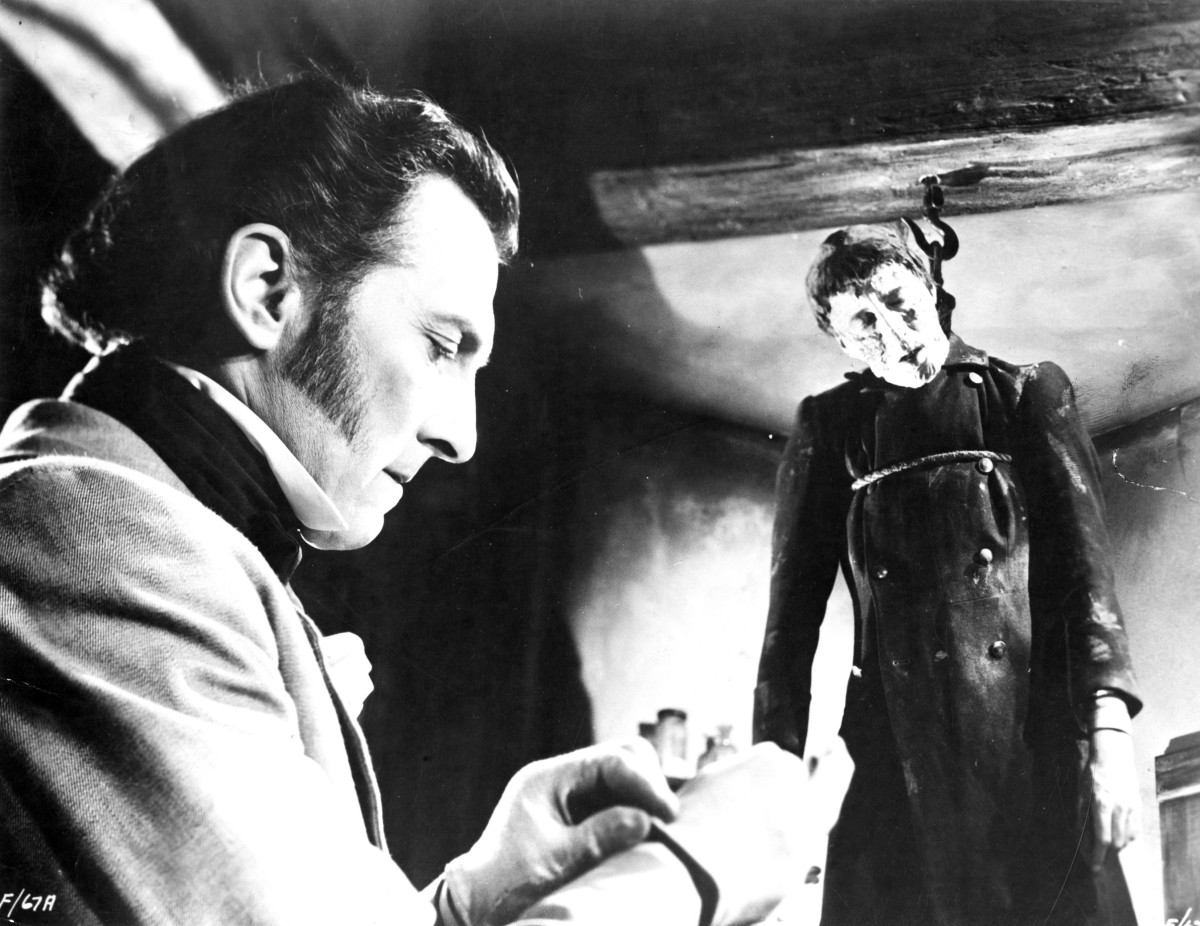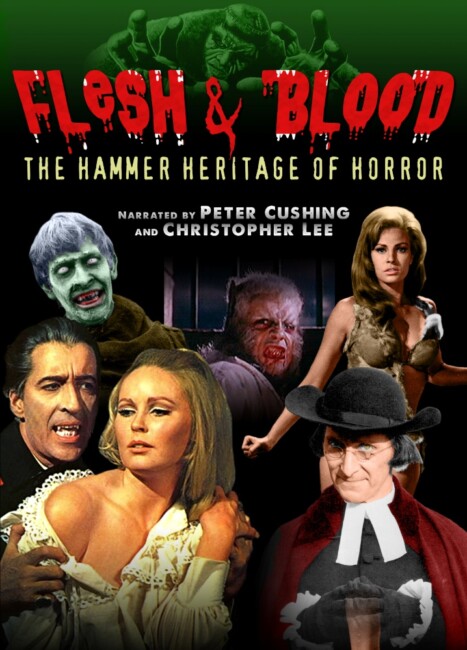UK/USA. 1994.
Crew
Director/Screenplay – Ted Newsom, Producers – Tee Boustow & Ted Newsom. Production Company – Act 3/Heidelberg Films.
With
Peter Cushing & Christopher Lee (Narrators). With – Roy Ward Baker, James Bernard, Martine Beswick, Veronica Carlson, John Carpenter, Michael Carreras, Hazel Court, Joe Dante, Freddie Francis, Val Guest, Anthony Hinds, Francis Matthews, Ferdy Mayne, Ian McGregor-Scott, Caroline Munro, Christopher Neame, Ray Harryhausen, Terry Ilott, Andrew Keir, Richard Matheson, Ingrid Pitt, David Prowse, Jimmy Sangster, Martin Scorsese, Don Sharp, Yutte Stensgaard, Raquel Welch, Aida Young
Hammer Films is a legendary part, if not the cornerstone of the Anglo-Horror Film. Although they had been around since the 1930s, Hammer’s success began in the late 1950s with the dual hits of The Curse of Frankenstein (1957) and Dracula/The Horror of Dracula (1958), which made the careers of stars Christopher Lee and Peter Cushing and most of those involved. Hammer made 166 films before they closed up shop in 1979, reviving again for a couple of tv series in the 1980s and later in the 2010s after the name was brought out. Most of their films are in the horror genre, including a string of Frankenstein and Dracula sequels, remakes of other horror classics and assorted psycho-thrillers and prehistoric adventures, although they also ventured into historical films, SF and some comedies and dramatic works. (See Hammer Films for a full listing of their works).
Flesh and Blood: The Hammer Heritage of Horror was a documentary made by US director/writer/actor Ted Newsom (1952-2020). Newsom started out writing porn films before making his directorial debut with the horror films Evil Spawn (1987) and writing Blood Frenzy (1987). He went on to direct The Alien Within (1990), The Naked Monster (2005) and Whispers from a Shallow Grave (2006), as well as a series of documentaries on genre subjects such as Frankenstein, Dracula, werewolves, dinosaurs and such luminaries as Edward D. Wood Jr, Vincent Price, Frank Sinatra, Marilyn Monroe and Kirk Douglas, as well as to script a whole bunch of others. He has also made a number of acting appearances, including some twenty parts in the films of Fred Olen Ray.
Flesh and Blood: The Hammer Heritage of Horror was a Documentary made for tv. It was the last screen pairing of Christopher Lee and Peter Cushing, who act as the narrators. While Biggles (1986) was Cushing’s last role on film, the narration here was his last paying film gig before his death in 1994. Indeed, 1994 was the perfect time for the making of the film – there have been other Hammer documentaries since then but this was the last opportunity when most of the key Hammer principals who are interviewed – Peter Cushing, Michael Carreras, Val Guest, Freddie Francis, Jimmy Sangster, Andrew Keir, Don Sharp, Anthony Hinds, Richard Matheson and Roy Ward Baker – were still alive.
The original version of Flesh and Blood runs to 100 minutes but a later version, the one released to dvd, extends that to 146 minutes. There have also been some scenes added, clearly shot later, that take things up to the point when the Hammer name was about to undergo its revival in 2010. It is rather quaint looking back on the film in 2024 to see people getting all excited about classic Hammer Films now being … released on VHS!

Flesh and Blood: The Hammer Heritage of Horror takes quite an exhaustive look at the Hammer Films story. It traces the company’s history all the way back to when it was Exclusive Films and shows clips from early films like Song of Freedom (1936) and their second film, the Bela Lugosi starring The Mystery of the Marie Celeste (1935). The 1940s brought increased popularity with radio-adapted works such as the Dick Barton films and The Adventures of PC 49 (1949) and The Man in Black (1950). The company was rebranded as Hammer Films in 1949, taken from a pseudonym used by founder William Hinds. The 1950s brought increasing strength through the production of quota quickies (films made to fulfil a mandate by the government that twenty percent of films released in the UK had to be British-made) using imported American stars – some of their earliest successes came in nineteen films that were picked up for international distribution by US producer Robert L. Lippert.
We then move to the films that made Hammer famous. Antony Hinds acknowledges the long-time rumour that The Curse of Frankenstein was originally pitched as a script by later-to-be Amicus founders Milton Subotsky and Max J. Rosenberg, but says that their version was unusable. He also offers the intriguing titbit that the original plan was to cast Boris Karloff as the Baron and how they faced a potential lawsuit from Universal if they used the makeup from Frankenstein (1931), necessitating they take a very different approach. The film even diverts off to discussing oddities like their collaboration with the US-made Tales of Frankenstein (1958) tv pilot.
Christopher Lee speaks of nearly being blinded when the red dye from the blood ran into his eye in the scene where he is shot in The Curse of Frankenstein. There is even behind-the-scenes footage from the set of Dracula – Prince of Darkness (1965), where incredibly enough we find that Lee did his own stunts, including allowing himself to be drowned beneath the iced-over lake where we clearly see that it was he not a stunt person doing the job. Lee repeats the oft-stated rumour that Michael Carreras would call him up every year and beg him to do another Dracula film because the success of the company depended on it. Lee also states how he quit doing the Dracula films after The Satanic Rites of Dracula (1973), feeling that the character had lost its mystique.

Flesh and Blood: The Hammer Heritage of Horror covers most of the Hammer story, even diverting away from their horror material to touch on their prehistoric exotica cycle and non-genre films like On the Buses (1971), although does skip over their historical films. Michael Carreras speaks about their remake of She (1965) but admits that they had to do so with a budget that was far less than the one available to the previous version She (1935). There is Raquel Welch interviewed about One Million Years B.C. (1966), saying she took the role and appeared in a bikini, believing that nobody would ever remember the film.
There are candid admissions – Michael Carreras stating that the idea of updating Christopher Lee’s Dracula to the present-day in Dracula A.D. 1972 (1972) didn’t work; Jimmy Sangster saying that he regarded his directorial debut Lust for a Vampire (1971) as an embarrassment; and Peter Cushing rather amusingly on how the wig he was given in Frankenstein and the Monster from Hell (1974) made him “look like Helen Hayes.”
A little time is even spent on works influenced by Hammer ranging from The Trollenberg Terror (1958) to Blood of the Vampire (1958) and copies such as I Was a Teenage Frankenstein (1957) to parodies like The Fearless Vampire Killers (1967), of which apparently Christopher Lee was not a fan, to imitators like Roger Corman’s Edgar Allan Poe films and Amicus to others that paired Lee and Cushing such as Horror Express (1972).
There is discussion of the end of Hammer, which seems to have occurred with Michael Carreras and Anthony Hinds’s retirement in the early 1970s and the studio’s management by hands with a less adept feel for the material. The film ends with sections that make mention of the 2010 revival of the Hammer brand with Let Me In (2010), which had just started shooting when Flesh and Blood was given its dvd release.
Trailer here


